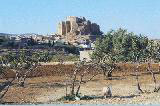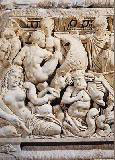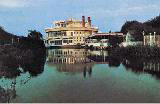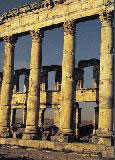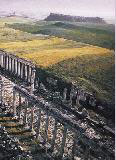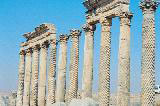Homs
It still retains this position of importance today, as the oil pipelines pass through the city.
Unfortunately, many buildings and citadels in Homs were destroyed by ancient earthquakes. There remains only one citadel in the south of the city with its Damascus and Palmyra gates.
The historical city produced many impressive personalities. Bassianos (an emir of Homs), through his daughter's marriage to the Roman emperor, Septimium Severus, who ruled Rome from 193 to 211, sired three rulers, Caracalla. Heliogabalus and Alexander Severus. The city was the birthplace of the famous Syrian philosopher, Longenius, counselor to Queen Zenobia, and of the famous physician, Marlian.
Among the most significant historic constructions remaining in Homs is the mosque of Khaled ibn al-Walid, the great commander of the Muslim Arab armies. Two very tall white-stone minarets lend lightness to the imposing structure. The slender colonnade in black and white stone in horizontal rows is representative of traditional Syrian architecture.
Many churches still stand in Homs from the days of early Christianity in Syria. One of these churches is said to possess the girdle of the Blessed Virgin. The church of St. Elian is unique for its collection of fine frescoes discovered in 1970. These bear inscriptions in Greek and Arabic, and date back to the end of the 12th century. The Nuri mosque also dates back to the 12th century, distinguished for its beautiful entrance.
In the Homs museum, there are many archaeological artifacts dating back to the ancient Syrian, Greek, roman, Byzantine and Arab eras.
The Qattina lake is 15 km from Homs, it is rich in fish, and has the first rainwater dam used in agriculture which dates back to the 2nd millennium B.C. close to this lake is the archaeological hill called.
This strategic location made Tadmor (Palmyra) prosper in a well-established kingdom from the 2nd century B.C.
However, Tadmor was located between two warring empires, Rome and Persia. Tadmor found that her interests lay more with rome, since the Persians had ambitions to take over the mouths of the Euphrates and Tigris rivers which would endanger Palmyra's trade.
When the Romans conquered Syria, Tadmor became known as the "city of palm-trees", and flourished even more: it imposed high taxes on goods from the caravans, and its horsemen fought alongside the roman armies. When the Roman emperor Adrian visited Palmyra, he declared her a "free city"; in return, the prople of Tadmor gratefully called their city "Adrianapalmyra".
When the Severus emperors, who were originally Syrian, came to rule Palmyra, they treated her people extremely well. The Emperor Caracalla declared her a Roman colony, something the Palmyrians had always hoped for, since it exempted them from paying taxes on luxury items such as perfumes, spices, ivory, glass and silk.
This made the city a luxurious one: new constructions, streets, arches, temples and statues were built, making Palmyra one of the greatest cities of the roman empire.
When the conflict between Persia and rome reached its crisis, Rome resorted to the ruler of Palmyra for help. This ruler, Auzaina, managed to withstand the Persian armies, which led the Romans to call him "The leader of the East". But he was soon assassinated in mysterious circumstances, and his second wife, Zenobia, a woman renowned for her exceptionally strong character, took power. She ruled Palmyra in a way that astonished both West and East. She was exceptionally intelligent and attractive. She was a gifted linguist, an eloquent speaker of Palmyrian, Greek and Egyptian. Zenobia had a wide knowledge of politics, and in her court, she has many philosophers, scholars and theologians.
Queen Zenobia was soon fired by the ambition of getting rid of Roman domination. In 268, during the reign of Emperor Aurelian, she decided to conquer all of Rome's territories. Aurelian was then very much engaged in internal conflicts well as external wars. This enabled Queen Zenobia to take over the whole of Syria, conquer Egypt and send her armies to Asia Minor, gaining control thereby of all the land and sea-ways to the Far East. She took the title of "August", which was only used by the emperor of Rome, and she has money coined with her and her son's likeness upon it, without that of the emperor of Rome.
However, the Emperor Aurelian took quick action in settling his internal disputes, and started to plan his revenge on Queen Zenobia. He formed a new army for this purpose, which proceeded through Turkey to conquer Zenobia's army in its first defensive position in Homs. It besieged Palmyra until it fell in 274. Queen Zenobia was defeated and taken captive to Rome, fettered in chains of gold.
The destiny of the great kingdom of palmyra was no better than that of its queen; the city fell prey to looting and destruction.
Archaeologists are still working on excavations there in order to uncover the queen's palace which was destroyed by the Romans and replaced by a military camp.
Queen Zenobia's ambitious dream is still embodied in the magnificent remains of what she built.
Palmyra lies 210 km northeast of Damascus and 155 km east of Homs. A tour among the ruins, which cover an area of 6 square kilometers, requires a full day in order to form an adequate idea of the beauty of the architecture which has remained. Worth visiting are the Baal temple, the Arch of Triumph, the amphitheatre, the baths, the "Straight Street", the Congress Council and the Cemeteries. Close to Palmyra, on a nearby hill, stands the citadel of Fakhr al-Din al-Ma'ni (17th century).
The museum of Palmyra (the Tadmor museum) is rich in art of different periods; sculpture, mosaic, gold, bronze and pottery. It also exhibits the folklore of Palmyra and the Syrian desert.
The spring of Afqa in Palmyra is the source of life of the famous oasis. Its sulphurous mineral water is said to aid in the treatment of skin diseases, chest and liver complaints and anemia. It also stimulates digestion and blood circulation.
Citadel Qal'at al-Hosn
The most famous medieval citadel in the world, Qal'at al-Hosn is 65 km west of Homs and 75 south-east of Tartus. It is 650 m above sea-level. It was built in order to control the so-called "Homs Gap", the gateway to Sryia. It was through this passage that Syria communicated with the Mediterranean.
In ancient times the importance of this strategic corridor was immense. It was of crucial importance to the Crusaders and other foreign invaders in their conquest of the coast. Conflict over the Crac des Chevaliers continued through the ages. It was a fierce and bloody dispute, but in the end, Sultan Beybars managed to recover it in 1271 through a military trick and one month of fighting.
Carc des Chevaliers was built on the site of a former castle erected by the emirs of Homs to accommodate Kurdish garrisons; "Carc" is a modification of the Arab word "Qal'a". The citadel covers an area of 3000 square meters and has 13 huge towers, in addition to many stores, tanks, corridors, bridges and stables. It can accommodate 5000 soldiers with their horses, their equipment and provisions for five years.
